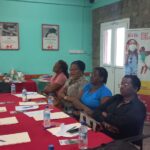
The Dominica Red Cross hosted its first-ever symposium of stakeholders to discuss activities of preparedness and opportunities for collaboration.
Disaster Risk and Management specialist of the USA Agency for International Development/ Bureau for Humanitarian Assistance (USAID/BHA), Cecil Shillingford spoke on two major improvements that have to be made in various sectors. These include the Institutionalization of Comprehensive Disaster Risk Management and food security.
Under the Institutionalization of Comprehensive Disaster Risk Management, Shillingford stated that plans are to be made to strengthen institutional structures that are in charge of Urban, Search and Rescue (USAR) in Dominica.
He said promoting the development of national USAR processes with the corresponding working protocols and procedures, resource inventories, and standardization, aligned with the international scope approved by the National Disaster Risk Management Authority, which guarantees the optimum response and professionalization of USAR Groups have to be done.
Shillingford called for “[the] support [of] the participation of technical institutions for the development of plans, strategies, and procedures for an efficient and effective USAR response according to the possible risk scenarios, their possible impacts, and their chain effects, according to the characterization of the present urban risk, which allows organizing, prioritizing, facilitating, and communicating the attention.”
In relation to another component; Emergency Management Services, he noted that USAID/BHA plans to promote strategies and actions that encourage the incorporation of methodological approaches for risk analysis, risk reduction, adverse event management, and recovery, with national, regional, and local scope among the official comprehensive Disaster Risk Management leading entities.
A contribution to National Risk Management Systems in the development of strategies that promote the interaction among different stakeholders, whose objectives focus on the management of adverse events, promoting synergies with interdisciplinary, cross-functional, and intersectoral approaches, was also mentioned.
The Enhanced Vulnerability and Capacity Assessment (EVCA) was discussed as a useful tool for resilience work because it serves as an entry point to the community and provides a holistic risk landscape of the community.
The EVCA has been adapted to better analyze the different characteristics of resilient communities.
The Vulnerability and Capacity Assessment (CA) is a participatory community risk assessment process and enables communities, with the support of Red Cross and Red Crescent National Societies when needed, to assess and analyze the risks they face, explore where these risks come from, which members of the community are most exposed, what coping capacities are available, and what initiatives can be undertaken to strengthen coping capacities and reduce the risks.
It allows communities to better understand the nature and extent of existing, changing, and emerging risks they are, and will be, facing and for communities to identify relevant and practical actions, reducing their risks and strengthening their resilience based on priorities.
DRC has about 300 volunteers in case of disaster and has installed storage faculties in different areas on island, such as Marigot, Good Hope, and La Plaine.
In Tarreau an eco-system restoration is being done in efforts to assist in the recovery of plantations that have been degraded or destroyed.
…




Disclaimer: The comments posted do not necessarily reflect the views of DominicaNewsOnline.com and its parent company or any individual staff member. All comments are posted subject to approval by DominicaNewsOnline.com. We never censor based on political or ideological points of view, but we do try to maintain a sensible balance between free speech and responsible moderating.
We will delete comments that:
See our full comment/user policy/agreement.